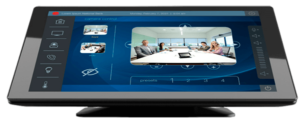Digital signage
Digital Signage is nothing else than central management of the content displayed on monitors in the company or on other premises. The panels may provide current information on what is happening at the facility or in a specific conference room. They allow for reviewing the events taking place in the buildings, e.g. in the form of a meeting calendar. They can also be used to display information messages or advertisements of business partners.
Using multimedia systems at the company enhances the prestige of the place where they are displayed, while using animations and different kinds of visual effects attracts attention and is better perceived by the customers.
An undoubtful advantage of audiovisual presentation systems is the possibility to easily adjust the image or content displayed to the current situation or need.









Infrastructure and service
No systems can operate properly without an appropriate infrastructure. The scope of our activities includes designing and installing the entire cable infrastructure. We also provide advice on the best locations and types of connections for a particular situation. We will also take care of modernizing the existing connections and cabling.
The Service Level Agreement (SLA) guarantees preventive inspections, provision of replacement equipment in case of failure and systematic software updates for the devices installed. We also provide the possibility of remote monitoring of the system operation.
The service scope includes:
- implemented systems maintenance
- consumables wear and tear inspection
- calibration of projector image, wireless microphones, interactive boards and connection sockets
- synchronization of connected devices
- diagnostic tests of the systems
We provide warranty for our services. We care for our customers, not only during the project implementation, but also after the AV system is implemented – we provide post-warranty care.














Monitors
Our solutions, such as: interactive screens, touch screen monitors or repeater screens, will enhance the company offering and draw the attention of employees and customers. Using screens increases positive experiences and is a perfect alternative for traditional content or advertisement presentation forms, such as posters, banners or billboards, which present static messages.
One possibility is to construct a video wall, using bezel-less monitors and touch screen overlays with a size of up to 500 inches with 32 touch points on the entire surface. Such solutions are excellent for companies or schools, and are great as one of attractions for the youngest customers of your facility. After appropriate content is created, the interactive solutions may be used for games and fun activities or as multimedia information boards
...
LCD monitors
LCD monitors are appropriate tools for presenting images for smaller audiences or displaying organizational information, they can also be an element of a repeater screen system. They are also used for information or advertising content visualization, for example, in shopping malls or traffic facilities, such as stations or airports.
The advantage of LCD monitors is higher contrast and perfect image quality not disturbed by the surrounding light. A drawback is the limited display size, which may be increased by connecting several bezel-less monitors to create a complete wall.
Touch screen monitors
Touch screen monitors are potable computers which concentrate all elements on a single screen. Operated with a touch, they prove to be a useful tool for audio and video processing, working with databases or as an equipment for operating specialty applications. Moreover, a monitor may be used as an additional display for a computer.
Interactive monitors
Interactive monitors with embedded software, connectivity and intuitive operation functions will make touch screen displays an engaging environment for making an effective presentation. They enable making quick notes, as well as writing or marking on the screen. The introduced contents may be easily erased or saved in a file. Additionally, the monitors offer numerous connectivity options and wireless screen sharing. Interactive monitors mostly have an embedded camera and soundbar.

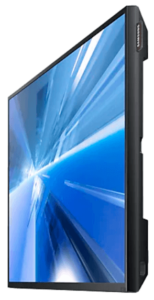

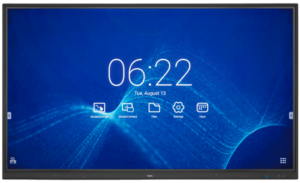





Projectors and screens
Multimedia projectors and projection screens are an inseparable part of every larger conference room. In order to ensure the best projection quality, appropriate device selection is required. The number of screens and projectors should be adjusted to the size and layout of the room so as to ensure good visibility for all meeting participants.
There is a wide selection of projection screens on the market. They can be initially divided into:
- wall-mounted, manually or electrically lowered;
- fixed frame and mobile.
A common solution for large rooms are repeater screens or one panoramic screen of a dozen meters or so. The panoramic screen allows for displaying images from several projectors without visible image connections or several independent windows (Picture in Picture), that is images from several sources at the same time.
Multimedia projectors may be divided based on their weight and mobility, projector power expressed in ANSI lumens and projection coefficient (the ratio between the projector distance and image width). This allows to determine the image size, while maintaining appropriate quality. The projectors designed for conference applications usually have moving lenses and may be placed close to the projection surface or, quite oppositely, at a significant distance, e.g. in the projection booth located at the other end of the corridor.
Our offer includes various types of modern projection screens, which we will tailor to the needs of our customer.

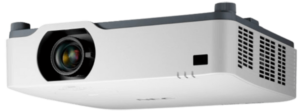
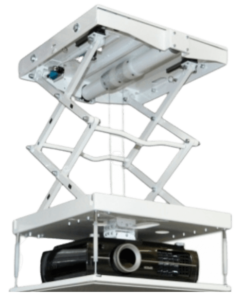



Microphone systems
Sound quality during a videoconference is of huge importance. It is very disturbing when we are having difficulties hearing our interlocutors and we are being asked to speak louder or repeat during a videoconference, therefore, it is very important for all meeting participants to clearly hear the speaker and the other people attending the meeting. Much depends on selecting proper microphone systems and on appropriate placement of the equipment.
It is important for the microphones to operate smoothly and have an intuitive control system.
Three basic types of microphone systems are distinguished:
- wired
- wireless
- microphone arrays installed for example in the ceiling, wall or table ...
In larger spaces and conference rooms, ceiling microphones with automatic, adaptive beamforming technology are more commonly used. The microphones automatically focus on the speaker and track their voice even if the speaker is moving around the room. An open media protocol (API) also allows for their integration with media control systems and cameras installed in the room. The ceiling arrays are an ideal solution for medium and large conference rooms, where they can be discretely installed in the ceiling and powered via Ethernet. For rooms of larger sizes or non-standard shapes, several ceiling microphones can be interconnected to ensure optimal coverage of the entire space.
When such a solution is used, there is no need for additional microphones or cabling and the space may be arranged in any way, while the participants can freely walk around the room.
For smaller rooms, microphones standing on the table or desk or those embedded in videoconference devices are completely sufficient.
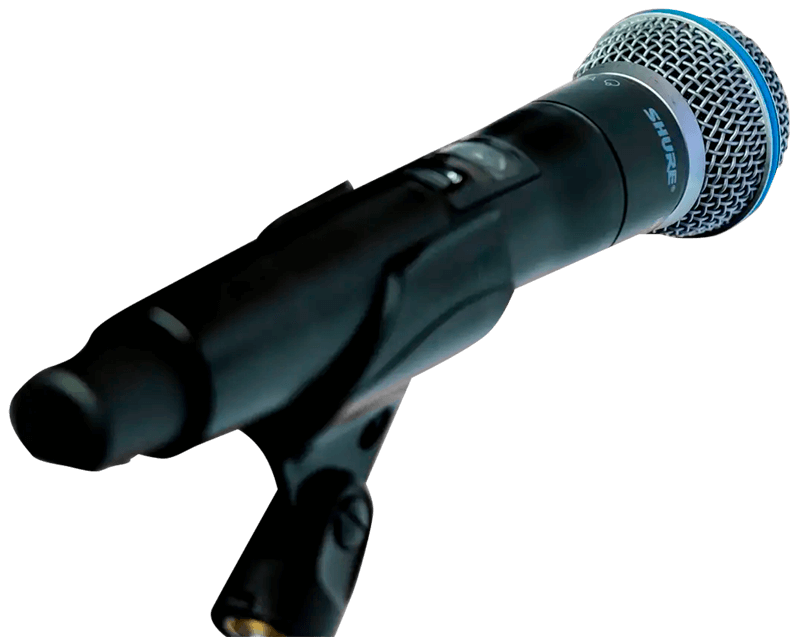
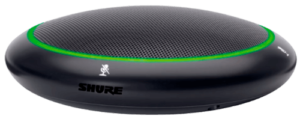


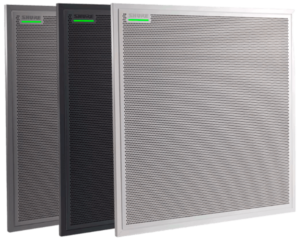


Sound systems
When planning a sound system for larger spaces or conference rooms, you should consider such factors as room dimensions, layout and acoustics. The size of the room is of key importance when it comes to choosing an appropriate number of speakers. It is important that the sound has uniform volume in the entire space, so that persons in the room could hear well and be heard in any situation. That is why professional ceiling or wall speakers are a worthy choice.
Connecting the audio system to the central control system will provide a simple way to adjust the volume to the needs of the customers in a given facility or to the nature of a specific event.
A comprehensive sound system installation includes:
- speakers
- audio consoles
- digital audio processors
- equalizers
- amplifiers






Reservation systems
Reservation systems facilitate the management of resources, such as, e.g. conference rooms, desks or parking spaces. These systems are excellent for companies with employee turnover in the office. A broad range of functions offered by these solutions allows for their integration with internal company systems, while ensuring security and privacy of internal databases. Their management is convenient and easy for the organization’s employees, who can make a reservation anywhere, using a mobile application, Outlook, MS Teams or dedicated booking panels.
Thanks to the analysis of resource usage data, the implemented systems allow to effectively manage the office resources.




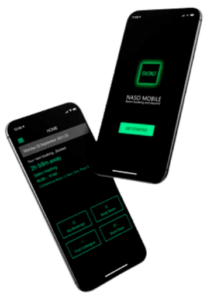



Control systems
Control systems provide easy and intuitive control over the installed AV devices and other technologies in the facility. They allow to manage, for example, air conditioning, lighting, shades, screens and sound systems. Control systems are created based on an individual software customized to the needs and aesthetic taste of the customer. Device management is performed using a tablet or LCD touch screen panel, so it eliminates the need for any remote controls.
We believe that it is important for the room management to be intuitive and convenient for users, so we make use of maximum device functionality during implementation.






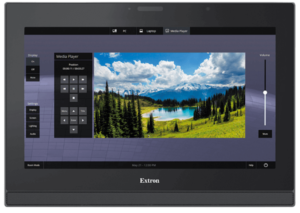

Videoconferencing systems
Remote communication has become common in companies. Holding business meeting without leaving the office allows to save time, reduce costs and quicken the decision-making process or consultation, e.g. with another branch of the company.
An integrated videoconferencing system provides a lot of convenience. A coherent arrangement of connected devices guarantees easy meeting management, high quality sound and image transferred in real time, without distortion and disturbance. The entire meeting can be managed using a computer, control panel or dedicated application.
The solutions in which the image is displayed on a single monitor with a conference soundbar equipped with microphone array and camera will be enough for small conference rooms. Interactive monitors with all elements required to hold a videoconference embedded are also available on the market.
For larger rooms, we recommend installing a professional videoconferencing system, which will provide the highest level of hybrid meeting realization for all participants.
A videoconferencing system most frequently includes:
- AV signal coding device
- PTZ (Pan-Tilt-Zoom) camera
- which frames the speaker
- microphone
- speakers

